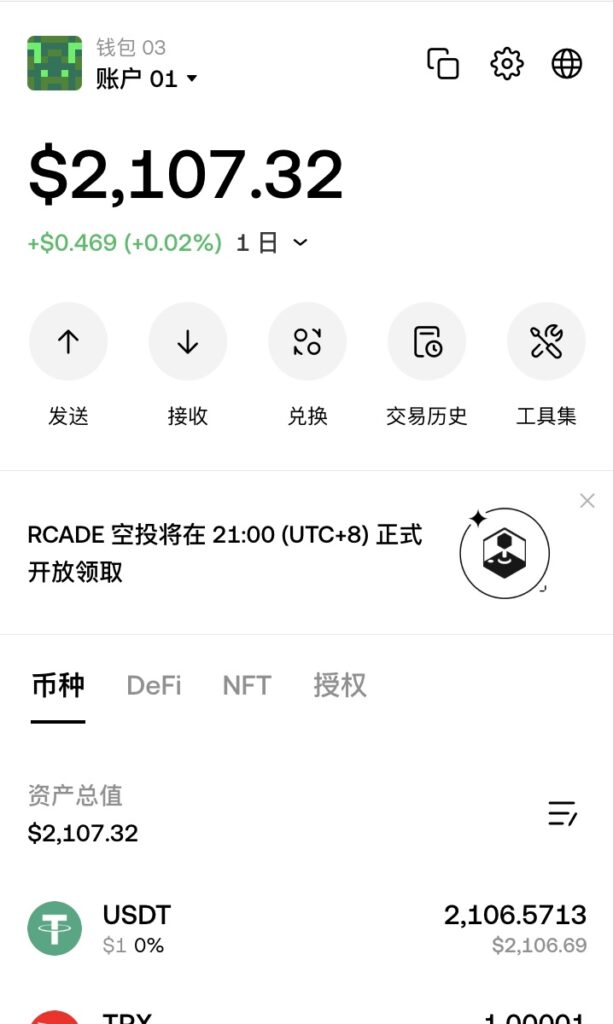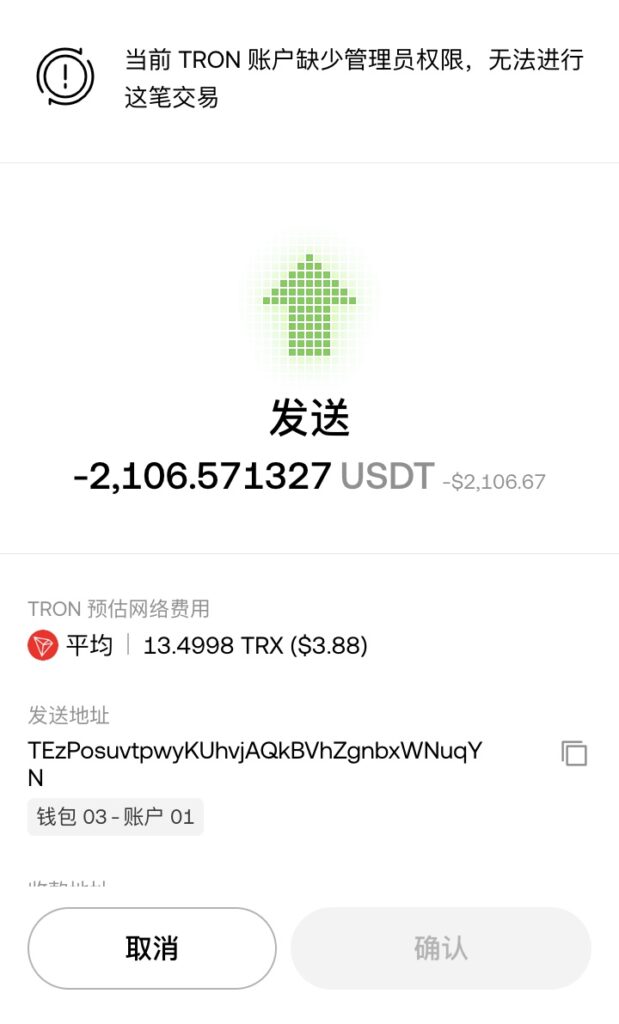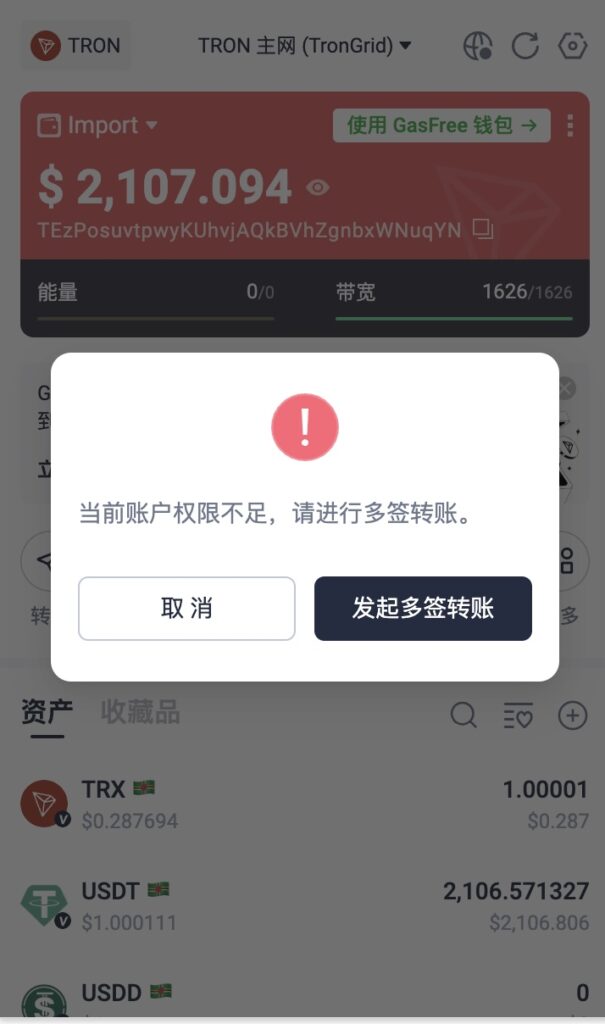今天开一个新的话题,给大家讲讲币圈入门,之前讲过交易,其实这期也差不多,现在我的YouTube(@shousake)订阅也有所增长,感谢大家的支持和鼓励,粉丝100以后在tg群 发奖励.
说到币圈,很多人可能觉得并不陌生,但恰恰想法,很对人对于币圈都是非常陌生的.这既因为币圈范围的广阔,又因为web3的绝对私有化,导致普遍信息差的存在,亏钱都是小事,被骗才是大事. Web3里面,诈骗横行,无数小白上当受骗,甚至骗局防不胜防.那么币圈入门的第一课我们就来聊聊,如何在web3中注意安全,教大家区分骗局.
(I).经典骗局
Tron多签,貔貅盘,各种搬砖,不知道你是否都了解其中的原理呢. 我们讲一个,最常见Tron多签,非常容易骗到一些小白,因为它操作简单,效果强,广被骗子使用.我们先来看张图.

这是一条来自我的视频的评论,我都被骗子盯上了! 也是借机会给大家讲一下. 第一,它的诈骗方式简单,仅仅是一个钱包问题.第二,你不需要任何多余操作,仅仅是从交易所打个钱就被骗了. 我们按照骗子的提示打开钱包,一探究竟: 骗子为什么能够成功获利?我们打开okx的钱包输入助记词看看情况.

我去! 2000USDT! 这骗子真是下了血本啊! 现在连诈骗行业都这样了吗? 以前我看到的都是几百,这直接来了个2000. 转个账试试.

经典来了,网费不足.不得不说这个链就是坑,没见过这么高的网费,这条破链就是明摆着坑人的,高额的网费,容易的诈骗. 新手就打钱进去了,然后会发现,也转不走,我以前蹲着上当者打钱是点击转账后,提示权限不足无法转账,根本没有什么提示. 这就是小白上当的主要原因! OKX钱包没有这方面的检测功能,小白们普遍认为,有了私钥就是有了完全掌握的钱包,等小白上当的,才告诉你没有权限,那么让我们一起探究一下这种东西怎么实现的,我们怎么警惕!

Tronlink当我们转账的时候就会提示多签,没错,骗子就是通过多签来保护钱,从而以网费骗小白打钱,据估算,一个月能骗到12000CNY左右!
(II).预防诈骗
上面这个经典骗局,说实活还是有很大的漏洞的,那么关键就在于有很多人,说着同样的话,干着同样的事,你难道不会觉得很奇怪吗?这些人诈骗语句都不带变的,第二,这个钱包为什么你打开时钱还在?第三,为什么要先交网费,你不怕截胡吗?第四,看看转账记录,不觉得有异常吗?是的!当时我不懂多签的时候就遇到这种诈骗了,我通过对以上4点分析,察觉到了很大异常,后来经过查找和探索,明白了其中道理.所以,当你能捡钱是,你要想想有没有什么异常.
(III).反省
对于刚刚进入一个不熟悉的环境时,不要轻举妄动,要多观察,多思考,任何情况都可能出现认知外的事情,只有当你了解清楚了,再去操作,才能保住万无一失. 了解概念是非常重要的,交易所做交易时,要了解现货,杠杆,合约的区别,到了web3后,对于区块链的系统运作要非常掌握. 以我的建议,先在中心化交易所,对简单的交易操作进行熟悉(Tele group来有手续费减免,最高60%),然后再去web3探索,对于小白,不要着急,可以来群里求助,问我都是没问题的. 如果你不信任我,也可以自己上网查找. 下一期,我会具体讲一下中心化交易所的基础操作,欢迎大家订阅我的YouTube和加入telegram群.
Crypto Beginner’s Guide (Part 1):
Today I’m starting a new series to help newcomers understand the world of crypto. I’ve previously talked about trading, and this episode will be in a similar spirit. My YouTube channel @shousake has recently seen a steady growth in subscribers—thank you all for your support and encouragement! Once we hit 100 subscribers, I’ll be giving out rewards in our Telegram group: https://t.me/+3i88vtmEf_hlZTNl.
When it comes to crypto, many people think they’re familiar with the term—but in reality, a lot of them are not. The crypto space is incredibly broad, and the decentralized, private nature of Web3 creates huge gaps in knowledge. Losing money is one thing, but getting scammed is far more serious. Unfortunately, scams are rampant in Web3, and many beginners fall victim to them—often without warning or any way to prevent it.
So in this first lesson, let’s talk about how to stay safe in Web3 and how to recognize scams.
(I) Classic Scams
Multi-signature scams on Tron, Ponzi-like high-yield scams, arbitrage traps—you may have heard of some of these, but do you really understand how they work?
Let’s talk about one of the most common: the Tron multi-signature scam. This one’s especially effective on beginners because it’s simple to execute and very convincing. It’s also widely used by scammers. Let’s take a look at an example.

Here’s a comment from one of my videos—turns out I’ve been targeted by scammers too! But this is a good opportunity to break it down.
First, the scam is incredibly simple: it’s just about a wallet.
Second, you don’t have to do anything complicated—you simply send funds from an exchange, and you’re already scammed.
Let’s follow the scammer’s instructions and open a wallet to see what’s going on. Why are scammers able to profit from this?
We’ll open the OKX wallet, enter a seed phrase, and…

Whoa! 2000 USDT!
This scammer really went all in—these days, even scammers are stepping up their game. I’ve seen wallets with a few hundred dollars before, but this one has 2000!
Let’s try transferring it out…

And here comes the classic move: “Insufficient network fee.”
Honestly, this blockchain is a trap—outrageous fees and poor transparency. It’s designed to trick people. A beginner sends in funds, then finds they can’t withdraw anything.
When I used to monitor scam wallets, I noticed victims would try to transfer but get error messages like “insufficient permissions.” No clear warning, no explanation.
That’s the main reason beginners fall for it. OKX Wallet doesn’t detect this kind of setup, and new users assume having the private key means full control. Only after getting scammed do they realize they don’t have the right permissions.
Let’s look into how this scam works so we can learn how to spot it.

In wallets like TronLink, a transfer attempt will show that multi-signature authorization is required. That’s the trick—the scammer sets up the wallet with a multi-signature mechanism to lock the funds, then lures beginners to send in more money under the pretense of needing to pay the network fee.
It’s estimated that a scam like this can bring in around 12,000 CNY (~$1,600 USD) per month.
(II) Scam Prevention
As simple as this scam is, it has some glaring flaws. The key is: why are so many people saying the exact same thing, using the same pitch? Isn’t that suspicious?
A few things to think about:
Everyone sounds the same—why no variation?
Why is there still money in the wallet when you open it?
Why do you have to pay the network fee first? What if someone else grabs the funds before you?
Check the wallet’s transaction history—don’t you notice anything strange?
When I first encountered this scam, I didn’t know how multi-signature wallets worked. But analyzing the above four points raised red flags for me. After some research and exploration, I figured it out.
Whenever something seems too good to be true—like free money—you should stop and think: is something off here?
(III) Reflection
When you’re new to any unfamiliar environment, don’t rush in blindly. Observe, think, and be cautious. Anything can happen beyond what you expect. Only once you’ve done your homework should you take action—that’s the only way to truly protect yourself.
Understanding the basics is critical. In centralized exchanges, you need to know the differences between spot trading, margin trading, and futures. When you move into Web3, it’s vital to understand how blockchain systems work.
My advice: start with centralized exchanges, get comfortable with basic operations (join our Telegram group for up to 60% fee discounts), and only then explore Web3. If you’re a beginner, take your time. You’re welcome to ask for help in the group—feel free to reach out to me anytime.
If you don’t trust me, do your own research online.
In the next episode, I’ll cover the basic operations of centralized exchanges in more detail. Be sure to subscribe to my YouTube and join the Telegram group!